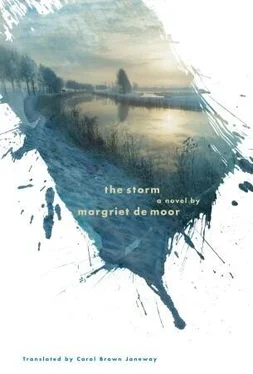“‘The people in The Hague could send us a plane, dammit!’ Nico van de Velde exploded at some point. And we looked up and saw an angry grumbler who was forgetting that the government doesn’t work on Sundays.
“‘Or a …’ came the prompt riposte from the birthing bed, ‘or a …’ and we all turned round or to one side and saw — I can’t describe it any other way, the bliss of Cathrien Padmos. Her large eyes were sparkling as she stared at us, her face was flushed with the slight fever that every woman experiences on the day she has given birth. Ignoring the fact that everything was pointing to the imminent end of the world, she was in that state of rapture induced by her optimistic, death-defying hormones.
“‘Or a helicopter …’
“As we looked at her, she looked down, but then there was another smile: she was reassured to discover that the baby was already suckling energetically at her breast. Now all we need is a modern miracle like a helicopter, she must have thought, and we’ll all be saved. But quick!
“That is how it was. An impossible situation that changed us all forever. I see us still sitting there in a sort of circle, marking off in the following order, if you imagine the hands of a clock: Cau, talking to himself, Zesgever, me, van de Velde, Hocke, his mother, Cornelius Jaeger, and Laurina van de Velde, who stood up from time to time to shuffle over to the godforsaken space between the two clothes cupboards, but nobody paid much attention. What is grief? Is it something that shows in a person’s face? Mrs. Hocke was the only other one I ever saw bending over that place, the others … didn’t want to? At least half of them almost certainly knew how things were with their own loved ones. So what were they supposed to do about this one death, such a tiny one, right next door?
“But the old woman did. I would never have thought that gold can contain its own light, and yet it must have been so in the two spirals that hung down to the left and right of her forehead. How otherwise could I remember so clearly how she looked? Her jaw muscles clenched as she bent over the place where Dina lay. Did she ask herself, I think she did, where this poor invisible little thing that she would certainly call a soul had gone? She belonged to the ultraorthodox Zeeland sect, so don’t be too quick to say: ‘to heaven,’ please! The catastrophe was still unfolding, houses everywhere were collapsing, when sermons started being preached again two days later.
“Imagine a barn, wet to saturation point, and a preacher on an upturned water barrel. When the congregation who have been standing shoulder to shoulder go their separate ways again, what they know is what they already knew. The flood — so says their dogma of guilt and punishment, and they deviate not one iota from it — is God’s spectacular but measured answer to our own provocations. I ask you seriously (Father, Mother, darlings, you’re both shaking your heads in exactly the same way), doesn’t this indicate an extraordinarily arrogant view of life? Punishment and guilt: the interaction of two great forces. And did you know, moreover, that brides from families who adhere to this sect wear black when they marry?
“Yes,” she would have said, “there’s a wedding photo of young Gerarda with her bridegroom and both their families. From left to right in front, on chairs, sit Cornelia Hocke-Heijboer, cousin of the bridegroom and sister-in-law of the bride; Sara Heijboer-Bolijn, sister of the bride and sister-in-law twice over of the bridegroom; Anthonie Hocke, the bridegroom; Gerarda Hocke-Heijboer, the bride; then the mother of the bride, Lena Heijboer-Koopman, widow of the mussel fisherman Iman Heijboer, and next to her Anna Leendrina Bolijn, aunt of the bridegroom and cousin by marriage of the bride’s mother Lena Heijboer. Behind these six seated people stand four men, of whom all I know is that they were brothers, brothers-in-law, and brother-in-law’s brother of either the bride or the bridegroom. The weather is splendid. The wedding guests have positioned themselves in front of the façade of a house or a farmhouse, shadowed by a tree in full flower. All of them without exception are wearing black. The five women have their hands in their laps, but Anthonie Hocke, the bridegroom, sits between them with his legs spread, his shoes shined to a mirror finish, and his hands in their thick knitted gloves on his knees in a pose that radiates masculine energy. Gerarda too is wearing black gloves. Of all the women, she, the bride, is padded out in the most clothing, wearing a long coat with lapels, and underneath it a dress that goes all the way to the chin. It is only Sara Heijboer, whose Zuidbeveland traditional dress includes a shawl that covers the upper arms, who lends the photo an idea of soft welcoming female flesh.
“Funereal? No, but serious. The scene isn’t funereal for starters because of the women’s snow-white caps, which separate the standing and seated wedding guests — four men and five women with the bridegroom in their midst — like a beam of light. With the exception of the Zuidbevelandish cap, in which the woman’s head and neck are framed like a shellfish in its opened shell, the caps stand away from the face, looking like bright starched veils made of floating snowflakes. How wonderful it must be to wear a crazy headdress like that! To hear everything grave and difficult in life discussed from inside the absolute privacy of such a white, translucently fine object cradling one’s head!
“Not all of them, no. Only the two young women, Sara Heijboer and the bride, wear the gold above their ears. And when I look at the only smile in the photo, on the face of the bride’s mother, and at the padded bride next to her, I know that the little ceremony has just taken place, in which the mother gives her daughter the precious head decorations like a dowry. She is to wear them, take care of them, and at the appointed time she is to give them to another young woman in the family.”
“As I already told you,” she would have said, “we all — every one of us — found ourselves in thrall to the situation. And the situation was the storm. And as we sat there the eye of the storm was, in some sense, us. Silent, empty, for one endless moment devoid of all character and devoid of all passion. How often do your eyes exist only because they’re looking, and your hands because they feel cold, and how often does the house you’re in exist all on its own, just because it’s still standing and will hopefully continue to do so, if God is good, until this terrible flood recedes again?
“But afterward … I know for sure that since that moment none of us is the same person we once were!
“And there were things to note about Simon Cau. Who was he? Was he a man of property, a dike sheriff, someone who attracts a circle of people wherever he goes? Extreme alterations in character seem to occur less frequently in reality than they do in books. But look at this! Simon Cau stands up, because he needs to use the bucket that’s behind the door to the entrance to the attic, with the sea splashing not even two steps below.
“He stands up, goes to the door, and closes it behind him, which it won’t do properly anymore because the frame is no longer aligned. It must be about four o’clock; the noon tide is very high again. When he comes back, he’s not looking down, as he did before, he’s glancing around searchingly, as if he’d forgotten where he’d been sitting. Then he strikes out. The bird, the goose, was just sitting where it had been sitting since the beginning, on a sort of hand-knotted Smyrna rug (Mother, we made one at home ourselves once, do you remember, that little runner of stiff white canvas and the strands of wool, about three inches long, that we threaded through it and tied off on the back?), but Cau kicks the creature away and makes for his chair as if he has a right to cut his own diagonal straight across the room. He sits down in exactly the same position he had before.
Читать дальше












